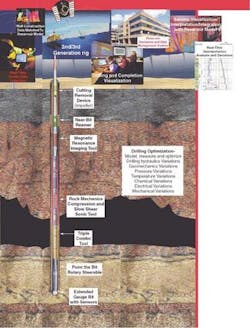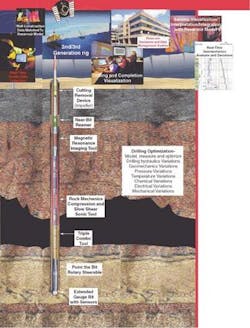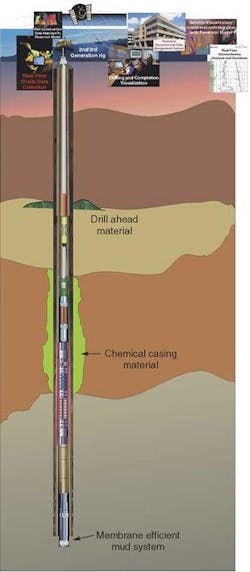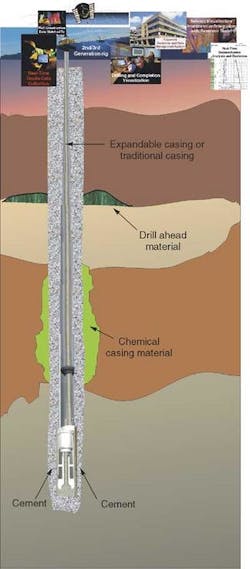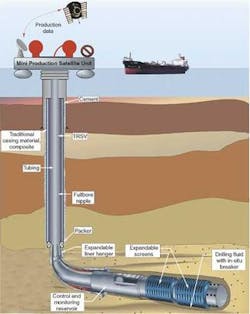Maximizing reservoir exposure, well productivity
Glenda Wylie
Frank Zamora
Dr. B.N. Murali
Halliburton
The monobore design incorporates technical advances in well architecture that have led to a uniform well diameter and fullbore production delivery conduit. From the well-construction processes to the end-product, technologies and processes work to increase efficiency. The monowell, drilled and cased with a uniform diameter from top to bottom, reduces cost per barrel of oil equivalent with improved technology efficiencies. The monowell makes use of the monodiameter approach, which drills with one diameter from top to bottom but may vary in diameter when casing is placed.
A monodiameter well can be constructed by placing nested expandables across multiple intervals. The goal is to reduce as many casing intervals as possible and place the well accurately across the reservoir. To extend hole intervals and optimize placement, data must be current and accurate, provided through real-time operations as changes occur.
Real-time data must also be accurately interpreted and analyzed with decisions following in real time. Visualization models involving the reservoir for all the arenas can help interpretation. Real-time information that updates the seismic, reservoir, geomechanical, and drilling models – including 3D and 4D visualization models – can allow updates and directives for the bottom hole assembly (BHA) for immediate drilling actions. The well-construction process can become more efficient and long-term well productivity can be improved by accurate placement of the well and completion design.
The pore pressure and fracture gradients of the formations being drilled largely dictate well designs. For example, two things can help extend hole intervals:
null
- Real-time feedback on actual vs. predicted pore pressure and fracture gradient
- Real-time methods to influence or manage pore pressure or fracture gradient.
Real-time analyses of pore-pressure, chemical/mechanical properties, fracture gradient, and borehole stability can be used to adjust the mud system in use, cement formulations, or other specialty fluids to enhance the mechanical strength of the formation while drilling. Also, pore pressure and fracture gradient data can be used in mechanical casing interval placement decisions. Real-time information might dictate shorter or longer intervals than originally planned. The aim is to maximize the length of the drilled intervals. Real-time, time-lapse resistivity can show permeable zones in the upper borehole that might cause borehole stability issues. Across the reservoir, the information can help in planning the optimum completion design.
Drilling long, open hole sections with potential open hole exposure to drilling fluids requires additional consideration. The drilling fluid system must be selected based on the desired penetration rate, hole cleaning, and long-term borehole stability of the formations being drilled. Chemical solutions and techniques can help extend casing setting lengths. Using expandable tubulars as mechanical support in combination with chemical solutions can result in requiring fewer "nesting" sections. Using chemical solutions with nonexpanded casing could increase the length of traditional casing lengths that could be run.
Desired attributes
Attributes of the BHA used to build the monowell should include:
- High level of efficiency getting to the desired location
- High borehole quality with minimal rugosity
- Appropriate drilling hydraulics to maximize hole cleaning
- High reliability and extended tool life.
Extending casing lengths requires the BHA to drill longer and with more precision. A steerable "point the bit" system provides the most efficient means of reaching the target location. Deflection of a shaft in the rotary steerable tool controls the extended gauge-bit direction. Bit loading is axial, allowing efficient concentric cutting of the formation, which leads to increased rate of penetration, increased bit life, and a smoother hole geometry. All of these qualities are needed in the construction of a monowell borehole. The system is directed by operators comparing actual and projected well plan data through the real-time system that reads information from the lithology and inclination sensors at the bit. This method allows immediate changes in direction, rather than delayed corrections, to be made to the steerable system. Real-time information, along with the right directional tools, provides the most efficient way to get to the target with the smoothest highest quality borehole.
null
High borehole quality can provide several monowell benefits:
- Reduced vibration means longer drilling tool reliability, better bit life, better toolface control, better weight transfer, and better cutter engagement to the formation.
- Hole cleaning is easier, resulting in reduced torque and drag on the BHA, casing is easier to install, and the chance to extend the longer monowell casing interval depths is greater.
- The tools have less chance of becoming stuck when a clean "gun barrel" borehole is provided, and better logging data can be collected.
Drilling fluid
The monowell's drilling fluid system must provide higher performance than what is normally required for an average well, including:
- Borehole stability in a variation of formation lithologies with increased time exposure and temperature variations
- Increased efficiency of borehole cleaning and hydraulics due to drilling longer intervals
- Reduced friction between the drillpipe and borehole with a more lubricious drilling fluid
- BHA cooling for the longer intervals to be drilled
- Environmental performance for the best overall well-construction efficiencies and regulatory compliance.
Borehole stability in a variety of formation lithologies with increased time exposure and temperature variation should be addressed in the monowell. Coals, shales, sand stringers, carbonates, reactive clays (gumbo), and more may be drilled from surface to the reservoir barrier. The primary problems to be addressed when selecting a drilling fluid for the monowell include bit balling, hole enlargement or washouts, reactive shales, and formation creep. Several of these problems can result from mud pressure penetration. Invasion of mud filtrate and the resulting interaction with formation clays can lead to borehole instability such as sloughing or caving.
Individual formations, regions, well objectives, and environments should be considered when choosing the optimum mud system for the individual monowell case. Some synthetic systems can be used as a typical invert emulsion in the upper hole and be converted to a drill-in fluid for drilling the reservoir section to ensure reservoir productivity. However, a highly efficient water-based mud system might be the optimum in other cases. The chosen mud system must meet all the key elements – economics, environmental, and cultural considerations – to ensure sustainable development for generations.
Chemical solutions
Using various techniques to incorporate chemical treatments into the formations being drilled can reduce the number of casing strings, which is one of the primary goals of the monowell. During the drilling of a monobore, new well-construction methods can be employed when encountering low mechanical-strength formations, unconsolidated weak zones, or abnormal geopressure profiles that will allow extending the casing length.
These problematic situations would normally require running a casing string to seal off and isolate the offending formation. In the normal drilling process, drilling would stop while a casing string or liner is set – a procedure that consumes rig time and materials. Additionally, each traditional casing string installed reduces the wellbore diameter. A resilient chemical casing – one solution under development to increase pressure containment integrity – can consolidate and isolate zones to prevent fluid migration. With chemical treatments applied, drilling can continue to extend the casing intervals.
null
Borehole support
Real-time pore pressure, fracture gradient management and manipulation can result in longer casing intervals. The design for longer casing intervals, should consider additional stress loadings and temperature, pressure, and lithology variations. Various types of borehole supports can be considered in a reduced casing strings architecture. Nested expandables as well as chemical solutions have been mentioned. Traditional casing used as a second barrier to the chemical or expandable tubulars may be employed. Also, coiled tubing or continuous composite pipe may be considered as a primary or secondary barrier. Advantages of continuous pipe include fewer potential connection leaks and the potential for faster deployment. No long-term composite casing deployments have been reported.
Cementing considerations
Additional considerations should be made when cementing the longer upper interval(s) in the monowell. These include:
- What will the well and cement barrier have to endure during its lifetime?
- How will the increased length and temperature variations affect cementing stress loading and integrity?
- What cement chemical formulations characteristics are required?
- What execution practices could be employed to reduce flat time?
The goal for the monowell is to reduce the lifetime cost per unit by increasing efficiencies. To achieve this goal, the entire well construction process and long-term production/injection conditions should be considered. Longer casing and cementing intervals will have to endure temperature and pressure variations, including shrinkage and expansion, as well as bonding to various formations and different mechanical and chemical structural supports. The monowell cementing selection criteria needs to address long term/short term development sustainability issues for drilling fluids, including economics, environmental, and cultural considerations.
Evaluation
In the monowell, it is critical for formation evaluation to occur during the drilling phase rather than after the fact. Formation knowledge should be maximized at the onset so an operator can better address borehole stability or completion issues. In the upper borehole, the bit should travel the optimum wellpath. Evaluation of the formation drilled should be used to design the optimum completion. While drilling, the BHA should be able to capture pressure readings for pore pressures, monitoring vibrations, tortuosity, lithology characteristics, faulting (fracturing) characteristics, and drilling measurements that allow re-evaluation of the wellpath while drilling in real-time. The data received while drilling should be integrated with the reservoir and geomechanics models for an optimal monowell. Decisions include:
- Optimum pathway to optimum reservoir recovery
- Borehole quality
- Borehole stability
- Hydraulics, including equivalent circulating densities
- BHA tool reliability
- Borehole management (knowledge of where and when to apply borehole-strengthening materials and reservoir completion optimization).
Across the reservoir section, the BHA takes on the additional requirements of defining reservoir quality so the optimum completion can be executed. The reservoir should be evaluated from both a petrophysical and productivity viewpoint before reservoir changes or impairment occurs. For the monodiameter/monobore, the best formation evaluation would include measurements coming from sonic or nuclear magnetic resonance tools.
Monowell completion
The monowell completion begins with drilling of the reservoir section. Optimum well performance and reliability should be the primary focus. Ultimately, borehole quality leads to better production. Drilling the hole with a matched mud motor and bit and underreaming the hole in the same trip allows for a smooth wellbore to be achieved with minimal damage to the formation. The initial bit penetration has the most concentric cutter contact, while the follow-up underreamer provides for a smooth wellbore. The drilling fluid affects the borehole quality and overall well productivity. A drilling-completion fluid that basically "seals" the formation, minimizes fluid losses, provides a conduit for installation of the borehole structural support, and provides effective wellbore production delivery is needed.
Design drivers of monodiameter and monobore are united at the reservoir. The monodiameter well design strives to minimize the size of the wellbore, and the monobore design strives to maximize the reservoir exposure and the well's productivity. Using an expandable liner hanger can allow this union to occur. From the liner hanger to well total depth, expandable liners, expandable screens, traditional liners, traditional screens, other nonmetallic liners or fluid/proppant solutions, i.e., resins, can be used depending on the current and future requirements of the reservoir. The objective is to optimize both inflow and tubing outflow performance.
Finally, completion equipment in the completion string should be fullbore to complete the final delivery of an optimized well architecture. Depending on the location, safety and environmental concerns, governmental regulations, and the reservoir, the completion equipment may include fullbore safety valves, reservoir-pressure monitoring, shutoffs, fullbore nipples, measurements, evaluation, and various other devices for both long- and short-term benefits. Intelligent wells should be considered for long-term cost reduction. Additionally, intelligent well installation can be integrated with the wired composite coiled tubing for long-term, real-time reservoir dynamic process monitoring and management.
Acknowledgments
The authors thank Patrick Laursen, Tim Haggerty, Dennis Bateman, Rufus Mullins, Marty Paulk, Tom Carlson, Ron Hyden, and John Podowski of Halliburton, Enventure, Fiberspar, and Uday Tare of Shell for their support and assistance in preparing this paper. The authors also acknowledge Enventure for the accomplishments of expandable technologies.
Editor's Note: This is a summary of SPE 77628.
